6 Causes of Oil on Spark Plug Threads (and in Wells)
Maybe you’re completing some routine maintenance and you discovered the oil on your spark plug threads. Or perhaps you were troubleshooting why your vehicle had low oil and discovered that you had spark plugs covered in oil.
Either way, now that you’ve found it, you’re sure to have a few questions. Are you supposed to have oil leaking into the spark plug wells? Is it a big deal and what’s causing it?
We’ll answer all those questions here and – spoiler alert – it’s not normal. You’re going to want to fix it as soon as possible.
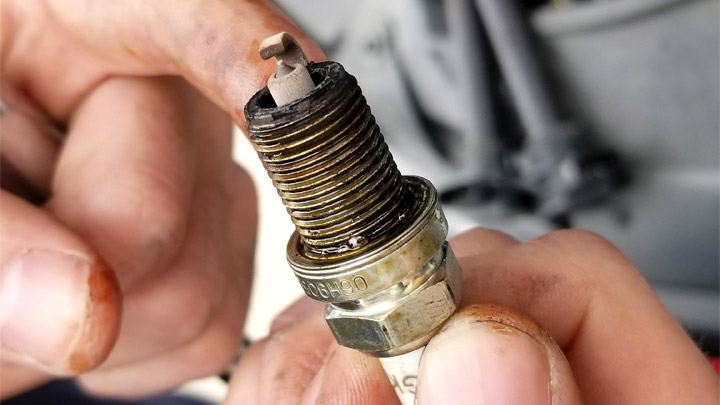
See Also: 9 Conditions of Spark Plugs (and What Each Means)
Reasons There’s Oil On Your Spark Plugs
Once you’ve discovered oil on your spark plugs, it’s time to dive into why it’s there. It’s not like there’s a spark plug gasket that’s leaking – so what’s going on? We’ve highlighted the most common reasons there might be oil on your spark plugs below.
#1 – Leaky O-Ring Seal
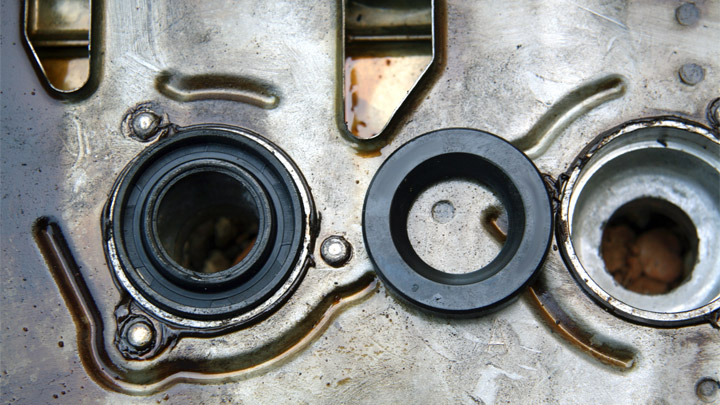
While your spark plugs might not have a gasket, they do use O-rings. These O-rings keep oil and everything else on one side of the spark plug, and the other side remains dry.
If you only have oil on one spark plug, you might have a leaky O-ring seal. This is one of the best outcomes if you have oil on your spark plugs. However, you still need to address the problem as soon as possible. Leaky O-ring seals can cause your engine to misfire and lead to more extensive damages.
See Also: Spark Plug Socket Sizes
#2 – Blown Head Gasket

While coolant in your compression chamber is what most people associate with a blown head gasket, another fluid that could be leaking is oil. When that happens, it’s common for oil to get into the combustion chamber.
You’ll notice excessive smoke, oil in your coolant reservoir, and there will be some oil on the tip of your spark plugs. You’ll need to replace the head gasket before the problem worsens and leads to more severe concerns. The good news is that head gaskets are cheap – the bad news is that it’s a labor-intensive process.
See Also: Cylinder Head Repair Cost
#3 – Worn/Leaking Valve Guides

Valve guides ensure that your intake and exhaust valves stay in the appropriate position at all times. Not only that, but they have seals that keep oil out of the combustion chamber.
If those seals give out, then oil gets into the combustion chamber, and it’s a quick hop, skip, and jump away from getting on the spark plug gaskets.
Like other components here, valve guides themselves aren’t that expensive, but they require a lot of work and time to replace – which can rack up a massive bill at the repair shop.
See Also: 3 Causes of Oil in an Intake Manifold
#4 – Valve Cover Gasket Leaking

Your vehicle uses valve cover gaskets to keep oil near components that need it and away from those that don’t. One of the components it keeps oil away from are the spark plugs. But if the valve cover gasket is leaking, then oil can easily seep into the spark plugs.
Like head gaskets, valve cover gaskets are cheap but it’s a labor-intensive process to replace them.
#5 – Damaged Piston Compression Rings
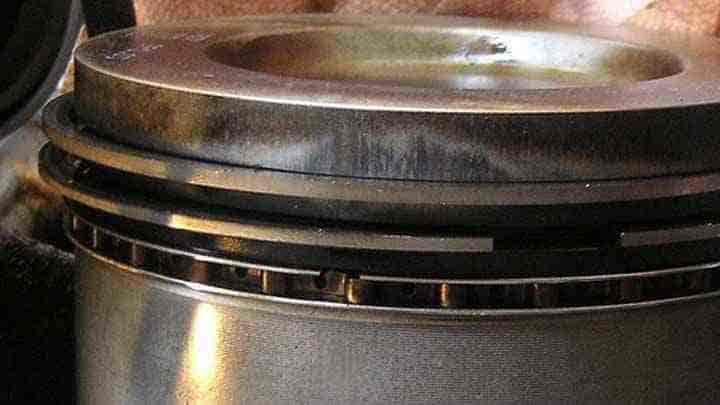
Around each piston in your engine, there are compression rings that keep oil from seeping into the combustion chamber. But when these compression rings are damaged, nothing is keeping the oil from seeping into the combustion chamber.
These rings keep everything running smoothly and prevent more significant problems. So, if you suspect damaged compression rings, it’s best to repair them as soon as possible.
#6 – Damaged Piston

While damaged or cracked pistons are rare, it’s not entirely unheard of. Combustion chambers get extremely hot, and as the pistons age, this heat can become too much for them. If you have a cracked piston, you’ll need an engine rebuild, which is not a cheap process.
However, if you let the problem go, you risk breaking down on the side of the road and potentially completely destroying your engine. Cracked or damaged pistons isn’t a problem you can ignore.
Read Also: 6 Causes of Oil Coming Out of a Tailpipe
How to Get Oil Out of Spark Plug Wells
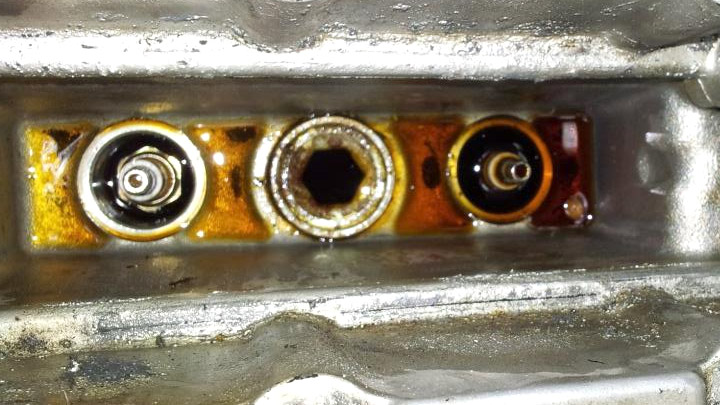
If there’s oil in the spark plug wells, you might be wondering what you need to do to get it out. The truth is that it’s more important to find the source of the problem and fix it.
That’s because the oil will work its way into the compression chamber and burn off. As long as there’s no more oil leaking in, that’s the end of your problem.
So, while oil on your spark plugs is a big deal – it’s not something you need to tear your engine apart to clean. Once you’ve found and repaired the faulty component, you should be good to go.
However, if you are worried about the excess oil, all you need to do is spray some carb cleaner into the spark plug holes and let the oil run into the combustion chamber. Reinstall the spark plugs and let your engine burn off the excessive oil.
See Also: Spark Plug Blow Out (Why It Happens and How to Fix It)
How to Fix: Oil On Spark Plugs
While simply cleaning off excess oil temporarily solves the fouled plug problem, pinpointing and repairing the root cause of the oil leak is necessary or you’ll just be repeating the same cleanup process.
Potential solutions include:
- Replace damaged or worn spark plug tube seals and O-rings allowing engine oil down into the well. Ensure the fresh seals are properly fitted.
- If oil smoke or coolant mixing suggests head gasket failure, replace the complete gasket set to prevent further compression leaks. This extensive engine repair restores the seal between the block and heads.
- For oil-fouled plugs alongside valve train noise, consider replacing worn valve stem seals and guides that have loose tolerances. This also necessitates some valve and cylinder head removal for access.
- Confirm piston, ring and cylinder wall wear as potential sources of oil blow-by internally in the engine, especially on high mileage vehicles. Engine overhaul and rebuild may be required in such cases.
While fouled spark plug replacement and wiring insulation cleaning may get a rough-running engine operational short term, the root sources listed above must get addressed to prevent ongoing oil contamination issues leading to misfire conditions or catalytic converter damage.
Can You Drive With Oil On Your Spark Plugs?
In short, yes, you can drive with oil on your spark plugs, but you’re going to want to figure out how it got there. That’s because oil on your spark plugs isn’t a normal condition, and it can be indictive a much more serious problem.
The oil on the spark plugs isn’t the problem – it’s how the oil got there that can damage your engine.
Can you Clean and Reuse Spark Plugs?
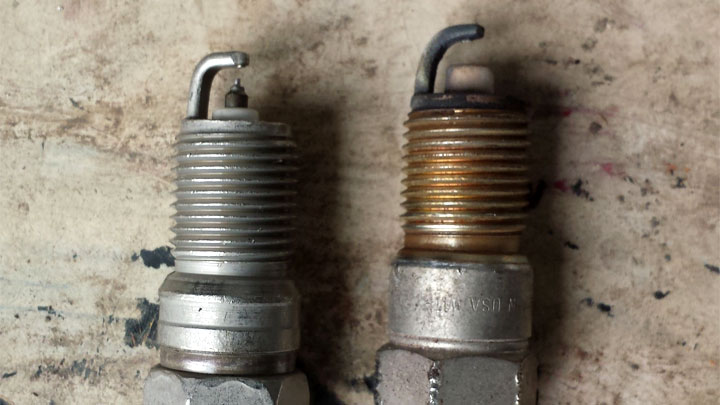
Absolutely! Once you’ve completed the necessary repairs to keep the oil from coming back, use a carb cleaner to spray down the electrode and threads and let everything dry. Once it’s dry, reinstall the spark plugs, and you’re good to go!
- P0521 Code (Symptoms, Causes, How to Fix) - Mar 22, 2024
- How to PROPERLY Clean 5 Types of Steering Wheel Materials - Feb 19, 2024
- What Should You Do If Your Check Engine Light Comes On? - Nov 6, 2023

Have oil on spark plug of Cylinder 1 of a Honda CRV.
If the valve cover gaskets is leaking would you expect oil on more than one spark plug?
If this is the case then something else in your list of possible causes is causing the problem …
Which side of the spark plug did you find the oil on? If it’s the valve cover gasket, you would see oil on the outside of the plug (where the coils or wires attach).
I think it depends on where the valve cover gasket is leaking. I can’t say for sure whether you’d only see oil on one or multiple plugs.
2011 Cadillac cts coupe 3.6 recently replaced spark plugs and all of them were wet with engine oil.
I have to travel 1200 miles back and forth… is there risk of permanent engine damage?
I don’t know. Did you ever determine the root cause of the engine oil on the spark plugs?
Thx for the tips. I was driving my 2016 2.4 Sonata and had put it in 1st gear. I over revved the engine before I put it back into drive. The engine stopped and now it won’t turn over. I pulled all 4 spark plugs and all 4 were coated with oil on the bottom of the plugs. Any ideas about the problem? I might be willing to fix the top end but not the bottom. 190,000 miles
It’s really hard to overrev an automatic. Even if you hit redline, that’s not over revving.
That said, check the intake to see if there’s excessive oil there. If there’s not, I might consider doing a leak down test to determine the source of the oil leak, since it’s internal.
I have a 06 dodge stratus all the plugs we’re dry but 1 front center plug had
Good amount of oil on it why would only 1 plug have oil
I don’t know. The oil could be leaking past the intake valve in that cylinder, or perhaps there is a seal leaking somewhere (like around one spark plug o-ring).
My jetta 6 doesn’t have power when I accelerate
There are many possible reasons a car could be down on power. Have you noticed any other symptoms? Is the check engine light on? Does the car stumble, hesitate, or misfire? Does it sound like the transmission is slipping (RPM increases but you don’t go any faster)?
So, how does the oil going up from the damaged piston ring end up on a spark plug thread screwed in the engine head?
Spark plugs seal above the threads. The flat seat that sits against the cylinder head acts as a gasket. If you have oil inside your cylinder from damaged piston rings, you can sometimes see oil on the spark plug threads.
If you have a bad valve cover gasket, sometimes you’ll see oil above this seal on top of the spark plugs.
AWSOME THANKS
Thanks for the intake and what to look for and needs to be done if oil is on spark plug or in spark plug well and how to clean and reuse spark plugs. This was a great help find a answer to that problem when I was changing the spark plugs on my 2006 V6 4.0L Nissan Pathfinder. Also the low Compression intake was a great help as well because as soon as I changed my valve covers and ignition coils spark plugs now I’m how that low compression problem. Cartreatment.com was and is a great website to go to for information on car problems.
Thanks
Thanks for the feedback, Gerald!